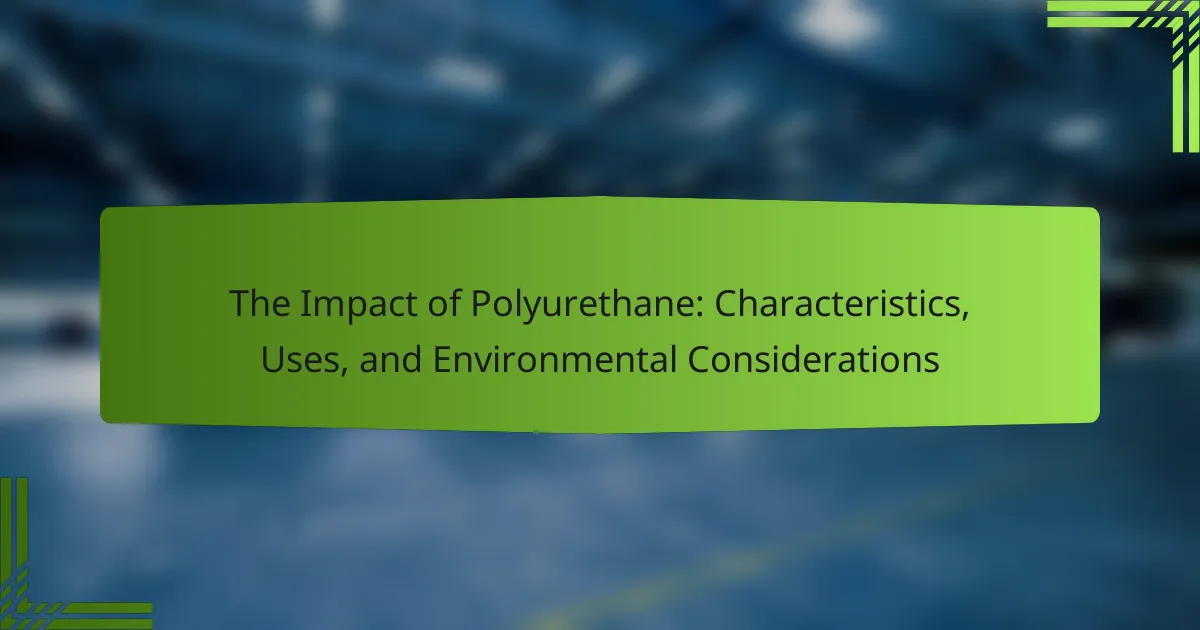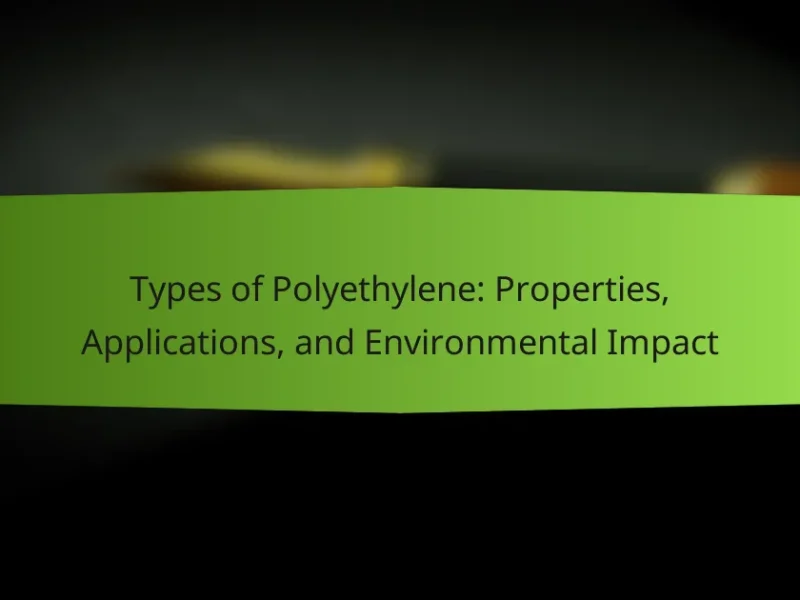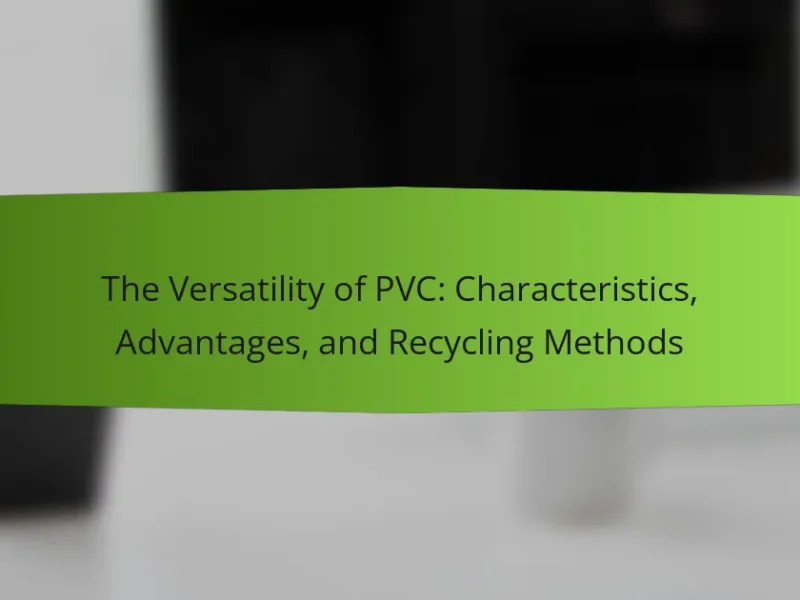Polyurethane is a versatile polymer widely utilized in various sectors, including automotive, construction, and furniture, due to its durability, flexibility, and resistance to wear. The global polyurethane market was valued at approximately $60 billion in 2021 and is projected to grow to around $70 billion by 2025, highlighting its economic significance. However, polyurethane production raises environmental concerns, such as fossil fuel depletion, VOC emissions, and challenges in waste management due to its long degradation time in landfills. The article explores the characteristics and applications of polyurethane, its environmental impacts, and emerging trends focused on sustainability and innovative recycling methods.
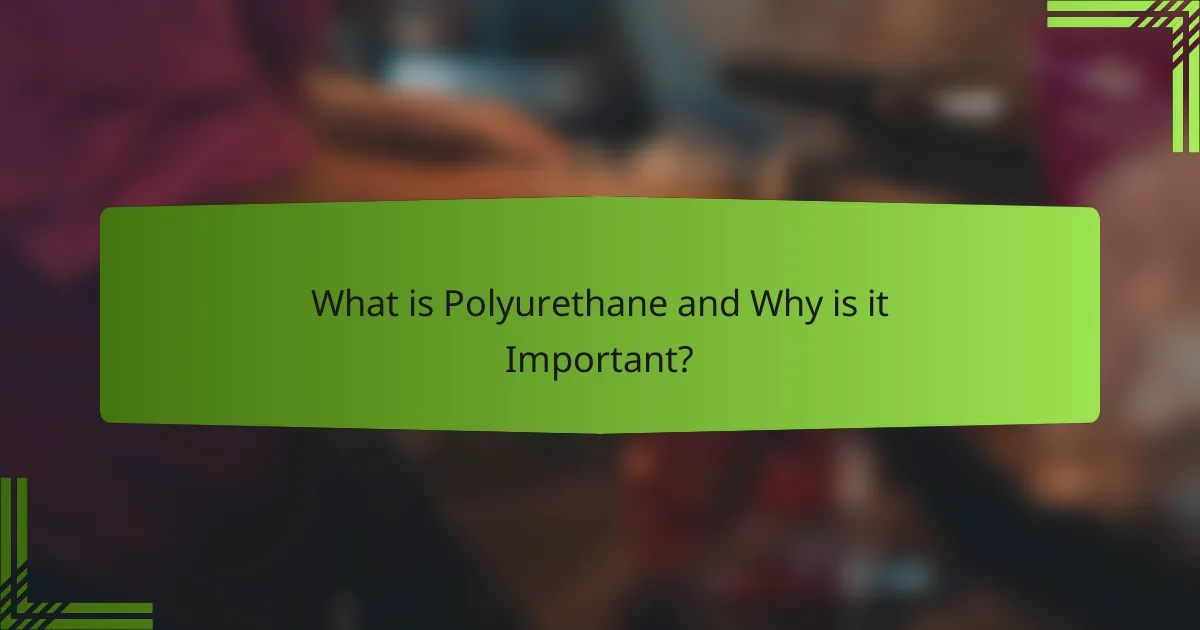
What is Polyurethane and Why is it Important?
Polyurethane is a versatile polymer used in various applications, including foams, coatings, and adhesives. It is important due to its durability, flexibility, and resistance to wear and tear. Polyurethane can be formulated to meet specific needs, making it suitable for industries like automotive, construction, and furniture. Its unique properties allow for energy efficiency and comfort in products like mattresses and insulation. The global polyurethane market was valued at approximately $60 billion in 2021, indicating its significant role in the economy. Additionally, polyurethane contributes to sustainability efforts by enabling lightweight designs that improve fuel efficiency in vehicles.
How is Polyurethane Manufactured?
Polyurethane is manufactured through a chemical reaction between polyols and isocyanates. This process occurs in various stages, starting with the mixing of these two components. The reaction creates a polymer that can be tailored for specific applications. Temperature and pressure are controlled to influence the properties of the final product. Additionally, catalysts and additives may be included to enhance performance. This manufacturing method allows for diverse forms of polyurethane, such as foams, elastomers, and coatings. The versatility of polyurethane is evident in its widespread use across industries, including furniture, automotive, and construction.
What raw materials are used in the production of Polyurethane?
Polyurethane is produced using two primary raw materials: polyols and isocyanates. Polyols are alcohols with multiple hydroxyl groups. They serve as the backbone for polyurethane. Isocyanates are reactive chemicals that contain the isocyanate group (-N=C=O). They react with polyols to form polyurethane polymers. Common types of polyols include polyether and polyester polyols. MDI (methylene diphenyl diisocyanate) and TDI (toluene diisocyanate) are frequently used isocyanates. These raw materials are essential for creating various polyurethane products, including foams, elastomers, and coatings.
What are the key processes involved in creating Polyurethane?
The key processes involved in creating polyurethane include polymerization, mixing, and curing. Polymerization involves the reaction of polyols with isocyanates to form a polymer chain. This reaction typically occurs in a controlled environment to ensure proper bonding. Mixing combines the polyols, isocyanates, and additives to achieve desired properties. The curing process involves the hardening of the mixture, allowing the polyurethane to set into its final form. These processes are critical for producing various polyurethane products, including foams, elastomers, and coatings.
What are the Key Characteristics of Polyurethane?
Polyurethane is a versatile polymer known for its unique characteristics. It exhibits high durability, making it resistant to wear and tear. Polyurethane also has excellent flexibility, allowing it to maintain its shape under stress. Its thermal insulation properties make it effective for energy conservation. Additionally, polyurethane is resistant to moisture, which prevents mold growth. This material can be produced in various forms, including foams, elastomers, and coatings. Its adaptability allows for a wide range of applications, from furniture to automotive components. Polyurethane’s chemical resistance further enhances its usability in diverse environments.
How does the flexibility of Polyurethane compare to other materials?
Polyurethane exhibits superior flexibility compared to many other materials. It can stretch significantly without breaking, often up to 300% of its original length. This flexibility makes it ideal for applications like cushioning and insulation. In contrast, materials like rubber can also be flexible but may not withstand as much deformation over time. Plastics generally lack the same level of flexibility and can become brittle. Studies show that polyurethane maintains its flexibility across a wide temperature range, unlike some other materials that may harden in cold conditions. This resilience contributes to its widespread use in various industries, including automotive and furniture.
What are the thermal properties of Polyurethane?
Polyurethane exhibits significant thermal properties, including low thermal conductivity and high thermal stability. Its low thermal conductivity typically ranges from 0.020 to 0.030 W/m·K. This characteristic makes it an effective insulator in various applications. Polyurethane can withstand temperatures from -40°C to 100°C without losing its structural integrity. Additionally, some formulations can endure even higher temperatures, up to 120°C. The material’s thermal properties are influenced by its chemical structure, which allows for flexibility in applications. These properties are crucial in industries such as construction, automotive, and electronics for energy efficiency and thermal management.
What are the Common Uses of Polyurethane?
Polyurethane is commonly used in various applications due to its versatility. It is widely utilized in furniture and bedding as foam cushioning. This material is also prevalent in coatings, adhesives, and sealants for its durability. Additionally, polyurethane is used in the automotive industry for interior components and insulation. Its applications extend to construction, where it serves as insulation material. Furthermore, polyurethane is found in footwear, providing comfort and support. Its use in medical devices showcases its adaptability in diverse fields. The global polyurethane market was valued at approximately $60 billion in 2020, indicating its significant presence in multiple industries.
In which industries is Polyurethane commonly utilized?
Polyurethane is commonly utilized in various industries, including construction, automotive, furniture, and footwear. In the construction industry, it is used for insulation and sealants. The automotive sector employs polyurethane for parts like bumpers and interior cushioning. Furniture manufacturers utilize it for upholstery and foam padding. The footwear industry incorporates polyurethane in shoe soles and cushioning materials. These applications highlight polyurethane’s versatility and effectiveness across multiple sectors.
What are the various forms of Polyurethane products available?
Polyurethane products are available in several forms. These include flexible foam, rigid foam, elastomers, coatings, adhesives, and sealants. Flexible foam is commonly used in furniture and bedding. Rigid foam is often utilized for insulation purposes. Elastomers provide durable and flexible materials for automotive and industrial applications. Coatings offer protective finishes for surfaces. Adhesives bond materials together effectively. Sealants prevent air and moisture infiltration. Each form serves specific applications across various industries.
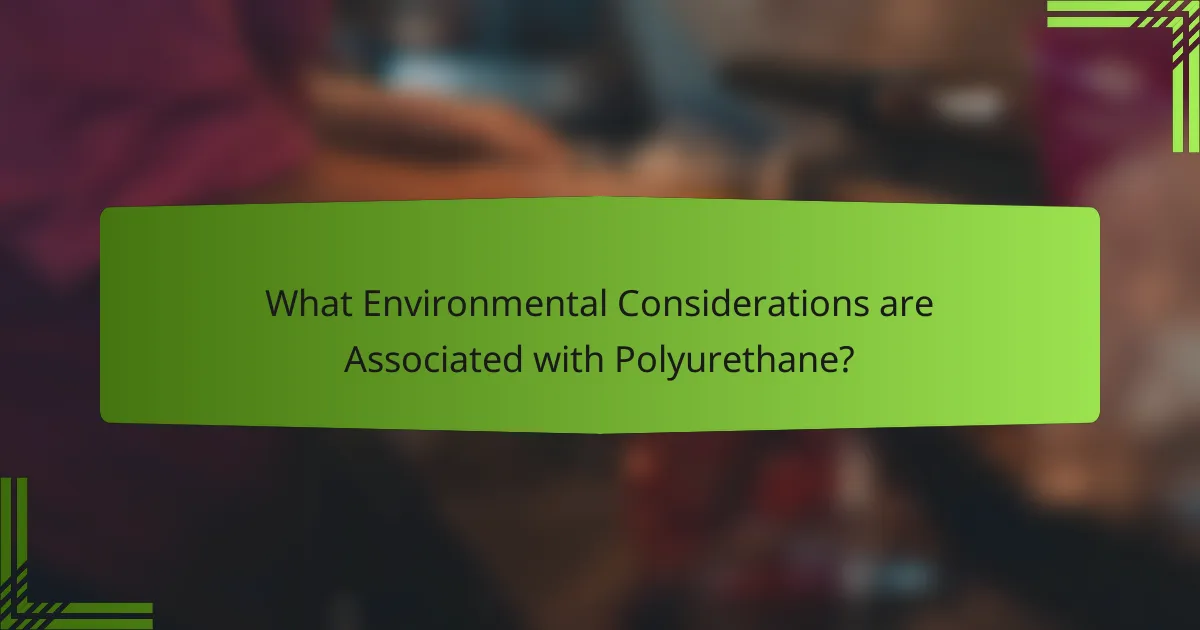
What Environmental Considerations are Associated with Polyurethane?
Polyurethane has several environmental considerations. It is derived from petroleum-based resources, contributing to fossil fuel depletion. The production process can release volatile organic compounds (VOCs), which are harmful to air quality. Polyurethane products can take a long time to degrade in landfills, leading to waste accumulation. Some formulations may contain harmful additives, such as isocyanates, which pose health risks during manufacturing. Recycling options for polyurethane are limited, complicating waste management. Studies indicate that the environmental footprint of polyurethane varies based on its application and lifecycle management.
How does Polyurethane impact the environment during production?
Polyurethane production impacts the environment primarily through the release of volatile organic compounds (VOCs). These compounds contribute to air pollution and can affect human health. The manufacturing process often involves the use of petrochemicals, which are derived from fossil fuels. This reliance on non-renewable resources contributes to greenhouse gas emissions. Additionally, the production of polyurethane can generate hazardous waste. Some of these by-products may require special handling and disposal methods. Research indicates that certain production methods can lead to water contamination if not managed correctly. Overall, the environmental impact of polyurethane production is significant and requires careful management.
What are the emissions produced during Polyurethane manufacturing?
Polyurethane manufacturing produces several emissions, including volatile organic compounds (VOCs), carbon dioxide (CO2), and isocyanates. VOCs are released during the production process, contributing to air pollution. CO2 is emitted as a byproduct of the chemical reactions involved in creating polyurethane. Isocyanates, which are precursors in polyurethane production, are also emitted and can be harmful to human health. According to the U.S. Environmental Protection Agency, these emissions can lead to respiratory issues and environmental degradation. Therefore, the manufacturing of polyurethane has significant implications for air quality and public health.
How does the lifecycle of Polyurethane affect its environmental footprint?
The lifecycle of polyurethane significantly impacts its environmental footprint. Polyurethane production involves petrochemical processes that emit greenhouse gases. During manufacturing, toxic chemicals may be released, contributing to air and water pollution. The use phase of polyurethane products can lead to durability and energy efficiency, reducing resource consumption over time. However, at the end of life, polyurethane is often not biodegradable, leading to long-term waste in landfills. Research indicates that polyurethane waste can persist for hundreds of years, contributing to environmental degradation. Recycling options exist but are limited, further exacerbating its environmental impact. Overall, the lifecycle of polyurethane presents both challenges and opportunities for sustainability.
What are the Recycling and Disposal Options for Polyurethane?
Recycling options for polyurethane include mechanical recycling and chemical recycling. Mechanical recycling involves shredding the material and reforming it into new products. Chemical recycling breaks down polyurethane into its original components for reuse.
Disposal options for polyurethane include landfill disposal and incineration. Landfill disposal is common but raises environmental concerns due to potential leachate. Incineration can reduce volume but may release harmful emissions.
The recycling of polyurethane is limited compared to other plastics. According to the American Chemistry Council, only about 10% of polyurethane is recycled. Proper disposal and recycling methods are essential for minimizing environmental impact.
How can Polyurethane be recycled effectively?
Polyurethane can be recycled effectively through mechanical and chemical processes. Mechanical recycling involves grinding polyurethane waste into small particles. These particles can then be used to create new polyurethane products. Chemical recycling breaks down polyurethane into its original monomers. This process allows for the production of new materials with high quality. According to the European Polyurethane Association, effective recycling can reduce waste and conserve resources. Recycling polyurethane minimizes environmental impact and promotes sustainability.
What are the best practices for disposing of Polyurethane products?
The best practices for disposing of polyurethane products include recycling, incineration, and landfill disposal. Recycling is preferred when facilities are available. Some manufacturers offer take-back programs for their polyurethane products. Incineration is effective for energy recovery and reduces landfill volume. Ensure that incineration facilities comply with environmental regulations. If recycling or incineration is not an option, dispose of polyurethane products in a landfill. However, this should be a last resort due to environmental concerns. Always check local regulations for specific disposal guidelines. Proper disposal minimizes environmental impact and promotes sustainability.
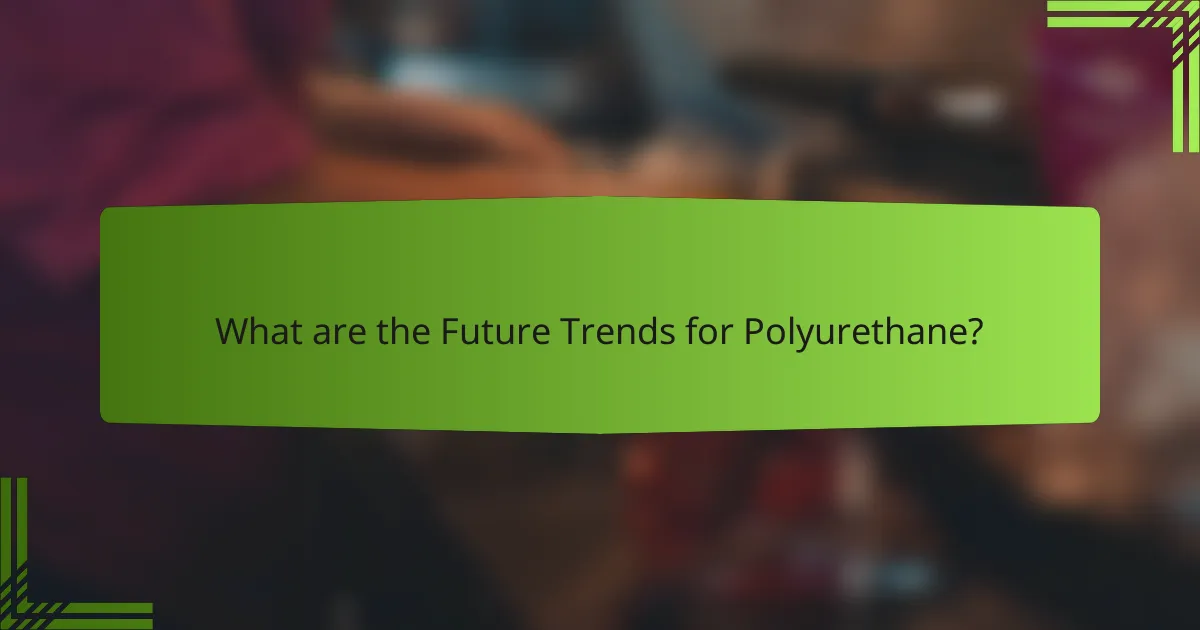
What are the Future Trends for Polyurethane?
Future trends for polyurethane include increased sustainability and bio-based alternatives. Manufacturers are focusing on reducing environmental impact. Innovations in recycling methods are being developed to enhance circular economy practices. The demand for lightweight materials in automotive and aerospace industries is rising. Advances in insulation technology are improving energy efficiency in construction. Smart polyurethane materials are being researched for responsive applications. Enhanced durability and performance characteristics are being prioritized in product development. The global polyurethane market is projected to grow significantly, reaching approximately $70 billion by 2025.
How is innovation shaping the future of Polyurethane applications?
Innovation is significantly shaping the future of polyurethane applications through advancements in formulations and processing techniques. New polyurethane formulations enhance properties like flexibility, durability, and thermal resistance. These innovations enable the development of lightweight and high-performance materials. For instance, bio-based polyurethanes are emerging, reducing reliance on fossil fuels. Additionally, improved processing techniques allow for more efficient production methods, minimizing waste. The automotive and construction industries are adopting these innovations for better insulation and energy efficiency. Research indicates that the global polyurethane market is projected to grow, driven by these innovations and increasing demand for sustainable materials.
What new technologies are being developed for Polyurethane sustainability?
New technologies for polyurethane sustainability include bio-based polyols and recycling methods. Bio-based polyols are derived from renewable resources like plant oils. These alternatives reduce reliance on fossil fuels. Advanced recycling technologies are also emerging. Chemical recycling processes can break down polyurethane into its original components. This allows for the reuse of materials in new products. Additionally, innovative additives enhance the biodegradability of polyurethane. Research indicates these methods can significantly lower environmental impact. For example, studies show that bio-based polyols can reduce carbon emissions by up to 50%. These advancements contribute to a more sustainable polyurethane industry.
What Practical Tips Should Be Considered When Using Polyurethane?
When using polyurethane, ensure proper ventilation in your workspace. This prevents inhalation of harmful fumes. Use personal protective equipment, such as gloves and masks, to protect your skin and respiratory system. Prepare surfaces thoroughly by cleaning and sanding to enhance adhesion. Apply polyurethane in thin, even coats for a smooth finish. Allow adequate drying time between coats to prevent issues like bubbling or uneven texture. Store polyurethane in a cool, dry place to maintain its quality. Dispose of any unused polyurethane according to local regulations to minimize environmental impact. Following these tips can lead to better results and safer handling.
How can users ensure safe handling of Polyurethane products?
Users can ensure safe handling of Polyurethane products by following specific guidelines. Always wear protective gear such as gloves, goggles, and masks. This minimizes exposure to harmful chemicals during application. Ensure proper ventilation in the workspace to disperse any fumes. Store Polyurethane products in a cool, dry place away from direct sunlight. Follow the manufacturer’s instructions for mixing and applying the product. Dispose of any waste materials according to local regulations. Regularly check for any leaks or spills during use to prevent accidents. These practices are essential for minimizing health risks associated with Polyurethane.
What maintenance practices can extend the life of Polyurethane items?
Regular cleaning and proper storage can extend the life of polyurethane items. Cleaning should involve using mild soap and water. Avoid harsh chemicals that can degrade the material. Ensure items are thoroughly dried after cleaning to prevent moisture damage. Store polyurethane products in a cool, dry place away from direct sunlight. Ultraviolet light can cause fading and deterioration. Additionally, avoid exposing items to extreme temperatures. These practices help maintain the integrity and appearance of polyurethane.
Polyurethane is a versatile polymer characterized by its durability, flexibility, and resistance to wear, used across various industries such as automotive, construction, and furniture. This article explores the manufacturing processes of polyurethane, its key characteristics, common applications, and environmental considerations associated with its production and disposal. It also examines future trends in polyurethane innovation, including sustainability efforts and advancements in recycling technologies. By detailing the impact of polyurethane, the article provides a comprehensive overview of its significance and implications for both industry and the environment.
